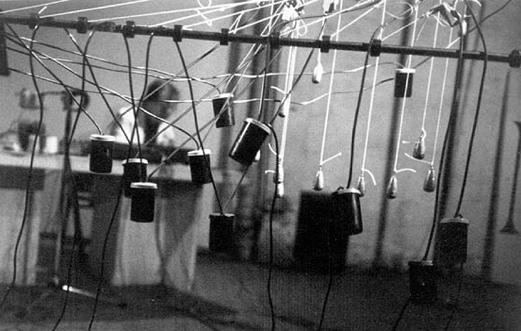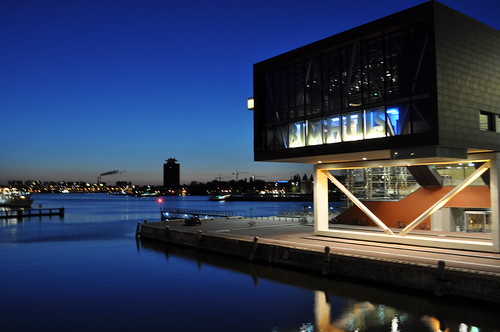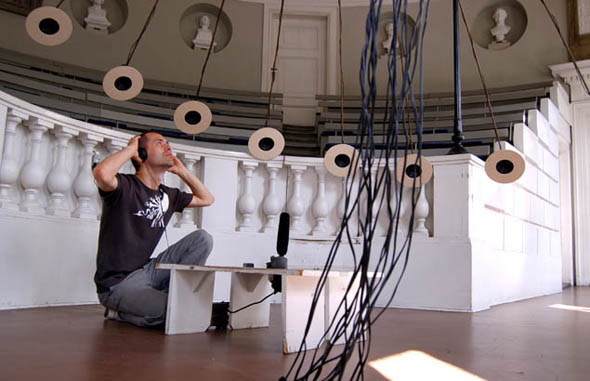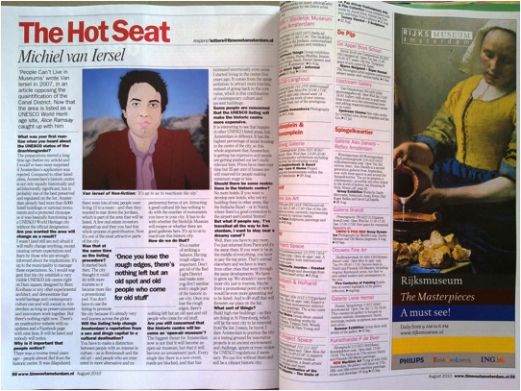Following my article ‘People Can’t Live in Museums‘ and an interview in this month’s Time Out Amsterdam, I decided to share some of my thoughts on the effects of an UNESCO-enlistment with the Dutch readers of the national daily newspaper NRC Handelsblad. They published my opinion article together with a crazy cartoon by Hajo de Reijger.
Although in Dutch, it resembles many of my long-standing views that I already expressed (in English) in my article and Time Out. Basically, I dare Amsterdam to position the city as a testing ground for innovative projects in an ancient environment and challenge, ignore or even violate the UNESCO regulations if necessary.

De grachtengordel is Werelderfgoed geworden. De stad moet nu niet verkrampen en niet meer toeristen verwachten meent Michiel van Iersel.
.
UNESCO, de onderwijs- en erfgoedtak van de Verenigde Naties, heeft de Amsterdamse grachtengordel op de Werelderfgoedlijst geplaatst. Maar de titel heeft niet de effecten die een ieder verwacht en is eigenlijk een wassen neus.
Voorstanders, waaronder de gemeentepolitiek en de behoudzuchtige Vrienden van de Amsterdamse Binnenstad, zien de UNESCO-titel als de hoogst haalbare onderscheiding. En sommigen zien er een kip met gouden eieren in, die voor veel extra toeristen zorgt. Het internationale adviesbureau PricewaterhouseCoopers heeft echter in 2008 berekend dat de gemiddelde stijging van het aantal toeristen bij een UNESCO-benoeming hooguit een paar procent is. In een ander onderzoek laat de meest gunstige berekening een stijging zien van zes procent, maar dat betrof het Canadese vissersdorp Lunenberg waar voorheen amper toeristen kwamen. In het wereldberoemde Amsterdam zal het effect aanzienlijk kleiner zijn.
Voorstanders voorzien ook een verandering van het soort toeristen dat de stad zal bezoeken. De ‘brallende Britten‘ zullen plaatsmaken voor kapitaalkrachtige kosmopolieten. Onderzoek weerspreekt ook dit: maar weinig toeristen zijn zich bewust van het UNESCO-predikaat van door hen bezochte plekken. De keuze voor een reisbestemming hangt hier nauwelijks van af.
Bovendien: was de titel vroeger nog voorbehouden aan de meest bedreigde natuurgebieden en de meest uitzonderlijke en kwetsbare architectuur en steden, inmiddels staan er meer dan 900 namen op de lijst en komen er ieder jaar gemiddeld 26 bij. Deze wildgroei zorgt voor een devaluatie van de benoeming.
Alleen al in Nederland stijgt het aantal kandidaten gestaag. De Wadden zijn net toegelaten en rondom Amsterdam bevinden zich al meerdere UNESCO-plekken, waaronder de Stelling van Amsterdam en droogmakerij De Beemster, die nauwelijks meer bezoekers trekken met hun titel. De reislustige Amerikaan kan Nederland ook overslaan en Aken, Keulen, Brussel, Brugge of Bath bezoeken om UNESCO-erfgoed te ervaren. Nog even en UNESCO is de Starbucks van de erfgoedwereld.
Volgens tegenstanders, de schreeuwerige actiegroep Ai Amsterdam voorop, is de benoeming de doodsteek voor de binnenstad. Amsterdam wordt één groot Begijnhof, als een overgereguleerd openluchtmuseum. Men vreest dat Amsterdam steden als Brugge achterna gaat en eindigt als uitgestorven erfgoedstad, zich niet realiserend dat Brugge pas in 2000 op de lijst is gezet, lang nadat deze stad haar dynamiek verloren had. De benoeming was een poging om de stad nieuw leven in te blazen.
Gemakshalve gebruikt men de benoeming vaak ook als bewijs voor de ‘vertrutting’ van Amsterdam. Maar wat de bescherming van erfgoed betreft is de hoofdstad Roomser dan UNESCO. Mede als gevolg van de bewonersprotesten tegen de sloop van oude wijken als de Jordaan in de jaren ’60 en ’70, ontwikkelde de stad zelf zijn strenge regels. De revolutionaire geest van weleer waart nu als een spook rond over de grachten en zorgt ervoor dat iedereen met (ver)bouwplannen snel wordt afgeschrikt. UNESCO doet daar amper iets aan af en draagt daar ook weinig aan bij.
Ook de angst voor verder toenemende regeldruk en bemoeizucht van de overheid is ongegrond. UNESCO is geen Paard van Troje dat ongemerkt ervoor zal zorgen dat gevelreclames en nieuwbouw verboden worden. Het reglement van UNESCO blinkt uit door vaagheid en laat veel ruimte voor interpretatie. Zelfs in Venetië, het prototype van de platgelopen toeristenstad waar sinds 1950 het inwonersaantal meer dan is gehalveerd, is ruimte voor vernieuwing en commercie. Zo werd twee jaar geleden, ondanks felle protesten vanuit de bevolking, een opvallende nieuwe loopbrug van de postmoderne Portugese architect Santiago Calatrava in gebruik genomen. En al enkele jaren ontnemen metershoge billboards met reclames het zicht op de bekendste architectuuriconen aan het Canal Grande en het San Marcoplein. En dit allemaal ondanks (of dankzij?) UNESCO én met steun van de lokale monumentendienst.
Dus hoe nu verder? Gewoon doorgaan, alsof UNESCO niet bestaat. Je moet het echt bont maken, of slecht spelen, wil UNESCO je van de lijst halen. Toen Dresden in 2009 van de lijst werd gehaald als gevolg van de bouw van een nieuwe brug, schreef de Frankfurter Rundschau terecht: “UNESCO is dan wel tot een besluit gekomen, het heeft geen oplossing gevonden.” Dresden koos voor innovatie ten koste van een plek op de lijst. UNESCO raakte een aanwinst kwijt en verloor de grip op een deel van de achterban.
Amsterdam moet zich spiegelen aan Dresden en zijn plek op de Werelderfgoedlijst gebruiken om deze ter discussie te stellen. Laat alle Amsterdammers, toeristen en bovenal UNESCO zien dat je als historische stad met een ‘uitzonderlijke universele waarde’ ook eigentijds en eigenzinnig kunt zijn. Amsterdam moet zich niet laten weerhouden van de hoogbouwplannen voor Overhoeks in Noord, volgens het UNESCO-reglement verboden, of voor de bouw van een nieuwe brug naast het Amstel Hotel, enkel vanuit een misplaatste eerbied voor UNESCO. Als men zo had gedacht in Parijs, waar het hoofdkantoor van UNESCO is gevestigd, dan zou er nu geen Centre Pompidou of glazen piramide bij het Louvre zijn. En dat was eeuwig zonde geweest.
This article first appeared in NRC Handelsblad, August 2, 2010.
UPDATE 1 – Belgian daily De Standaard refers to NRC-article
Aug 5, 2010 – In another UNESCO row (after Dresden it is Bruges’ turn), Jan Van Hove, the Culture editor of Belgian quality newspaper De Standaard, refers to Michiel van Iersel’s NRC article on the admittance of Amsterdam on the UNESCO World Heritage List. He suggests that Bruges should follow Michiel’s suggestion for Amsterdam to ignore UNESCO.

Here is the quote in Dutch, suggesting that Bruges should follow Michiel’s suggestion (for Amsterdam) to ignore its UNESCO-status and leave room for new developments in the historic inner city:
Misschien moet Brugge een voorbeeld nemen aan Amsterdam, dat sinds het voorbije weekend zijn grachtengordel op de lijst van het Werelderfgoed ziet prijken. De titel werd niet overal op gejuich onthaald, want sommigen vrezen dat de titel van de Unesco de strenge regelgeving die nu al bestaat, nog strakker zal maken. In de NRC verscheen gisteren meteen een opiniestuk waarin Amsterdam de raad kreeg om de Unesco gewoon te negeren. ‘Nog even en Unesco is de Starbucks van de erfgoedwereld’, schrijft de auteur, die erop wijst dat de titel van Werelderfgoed wel wat aan waarde inboet nu er 900 plekken op de lijst staan, alsof Unesco, zoals de bekende koffieketen, overal zijn filiaal wil.
According to another source, Patrick Moenaert, Mayor of Bruges, seems to agree:
“ To lose UNESCO classification would be terrible. Neither is it the objective to preserve the city like a picture postcard within which nothing can be altered. Bruges is not a shrine but a city which lives and must continue to live in the 21st century”
UPDATE 2 – Article published in 10 different languages
Aug 12, 2010 - After being mentioned as a source of inspiration for Bruges’ dealings with UNESCO in Belgian daily De Standaard, Non-fiction’s opinion article on Amsterdam’s inscription on UNESCO World Heritage List is now published on the website of Presseurop in 10 languages, ranging from English and German to Polish and Romanian. It’s interesting to see the differences between the various translations of the original headline, both in length and content, putting the emphasis on different aspects of the article.

PressEurop is a joint initiative of France’s Courrier International, Italy’s Internazionale, Poland’s Forum and Portugal’s Courrier Internacional. Every day, PressEurop selects stories from top publications across Europe and the rest of the world, including Der Spiegel and Le Monde . The site also includes press reviews, daily political cartoons, blogs and editorials.












